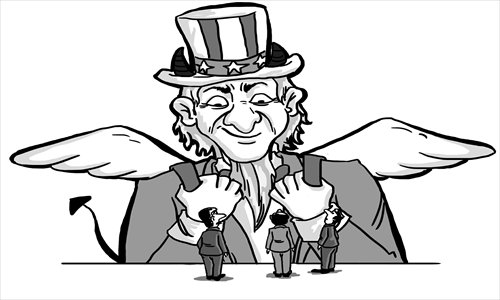
Illustration: Sun Ying
Talking about the Khmer Rouge with Tara, a Cambodian taxi driver, all
he knew was that in his village, some 30-somethings like him once went
to Phnom Penh to hear the trials of Khmer Rouge leaders. "Vehicles came
to pick you up, and you even got a free meal," said Tara, who lives in a
village not far away from Siem Reap.
Many Cambodians still
remember the Khmer Rouge era, which ended over 30 years ago. It is
estimated that during the ruling by the Khmer Rouge, which lasted 44
months, anywhere between 400,000 and 3 million people, out of a
population of less than 8 million, died of hunger, forced labor,
disease, torture, political persecution, or from other unnatural
reasons. The Khmer Rouge is still a frequent topic in Cambodian and
other Southeast Asian media.
One month ago, I attended an ASEAN
meeting at Siem Reap, and read a report published by the Cambodia Daily
on how a Cambodian man didn't learn until a recent trial of the Khmer
Rouge that his wife, who disappeared 34 years ago, actually died after
being imprisoned in a concentration camp.
More than a few
tourists arriving in Cambodia are also very interested in that period of
history. In the night fair at Siem Reap, one can find biographies
written by Westerners about Khmer Rouge leader Pol Pot, and books
revealing the horrors of Security Prison 21, that once confined
"political criminals."
According to the Thai media, Pol Pot's graveyard in northern Cambodia has become a newly developed tourist site.
In
Siem Reap, trials of the Khmer Rouge leaders are ongoing. Case 001, on
Kang Kek Iew, head of the Security Prison 21, was closed at the
beginning of this year, when he was sentenced to life imprisonment. The
current case 002 had four defendants, Nuon Chea, Khieu Samphan, Ieng
Sary, Ieng Thirith, and all of whom were leaders of the Khmer Rouge.
That
part of history has been taught at high schools since 2009, according
to arrangements by Cambodia's Ministry of Education, Youth and Sport.
Although that part of history is already remote to 30-somethings like
Tara, the memory of the Khmer Rouge hasn't completely faded out.
Historical
events can be tucked into a corner for a while. However, they won't
vanish, but will always jump out later in their own way.
When
people mention the Khmer Rouge, many might be reminded of the support
China once gave it. This is a problem that cannot be avoided. No matter
whether China wants it or not, as China's relationships with Cambodia
and Southeast Asia grow closer, people will allude to that history.
In
fact, in the US pivot to Asia, one important strategy is to take
advantage of the Cold War legacy. The historical shadow of the Khmer
Rouge lies behind recent Western finger-pointing that Cambodia is
risking the destruction of ASEAN unity over the South China Sea issue
just to cater to Beijing.
An interesting phenomenon is that the
Americans, who also provided support to the Khmer Rouge due to their own
needs in the Cold War, have now become the third largest donor of the
tribunal putting the Khmer Rouge leaders on trial. In comparison, in
China, this tribunal is even barely mentioned by the media yet.
Is it true that the US, which is seeking a pivot to the Asia-Pacific region, really has no historical burden? Absolutely no.
US
journalist Joel Brinkley, in his book Cambodia's Curse, states that
from 1970 to 1975, the US provided the Lon Nol administration with
military and economic aid worth as much $1.85 billion, or $9 billion if
calculated in 2010 dollars.
Who has studied about how many lives such aid cost in Southeast Asia?
But since the beginning of this year, the US government has done two things to address historical issues in Southeast Asia.
First,
it promised to spend $9 million to clear land mines left by the Vietnam
War. Statistics show that 90 million cluster bombs were drooped on
Laos, but were left unexploded at the time. These bombs are still
killing Laotians today.
Second, in August, for the first time
since 1975, the US embarked on a joint project with Vietnam to clean up
the toxic remnants of Agent Orange. During the Vietnam War, US planes
sprayed millions of gallons of the defoliant Agent Orange over Vietnam's
jungles to destroy the hiding places of the Viet Cong. Four decades on,
the chemical is still harming the health of ordinary Vietnamese.
Through
these actions, is the US simply seeking to fix its image? Certainly
not. These projects have been openly included as part of the US "back to
Asia" strategy. Just like providing support to the tribunal putting the
Khmer Rouge on trial, the Americans are trying to play the role of a
responsible leader in Southeast Asia.
It's probably time for us to seriously consider how we should deal with the historical issue of the Khmer Rouge.
The author is a senior editor with People's Daily. He is now stationed in Bangkok. dinggang@globaltimes.com.cn

No comments:
Post a Comment